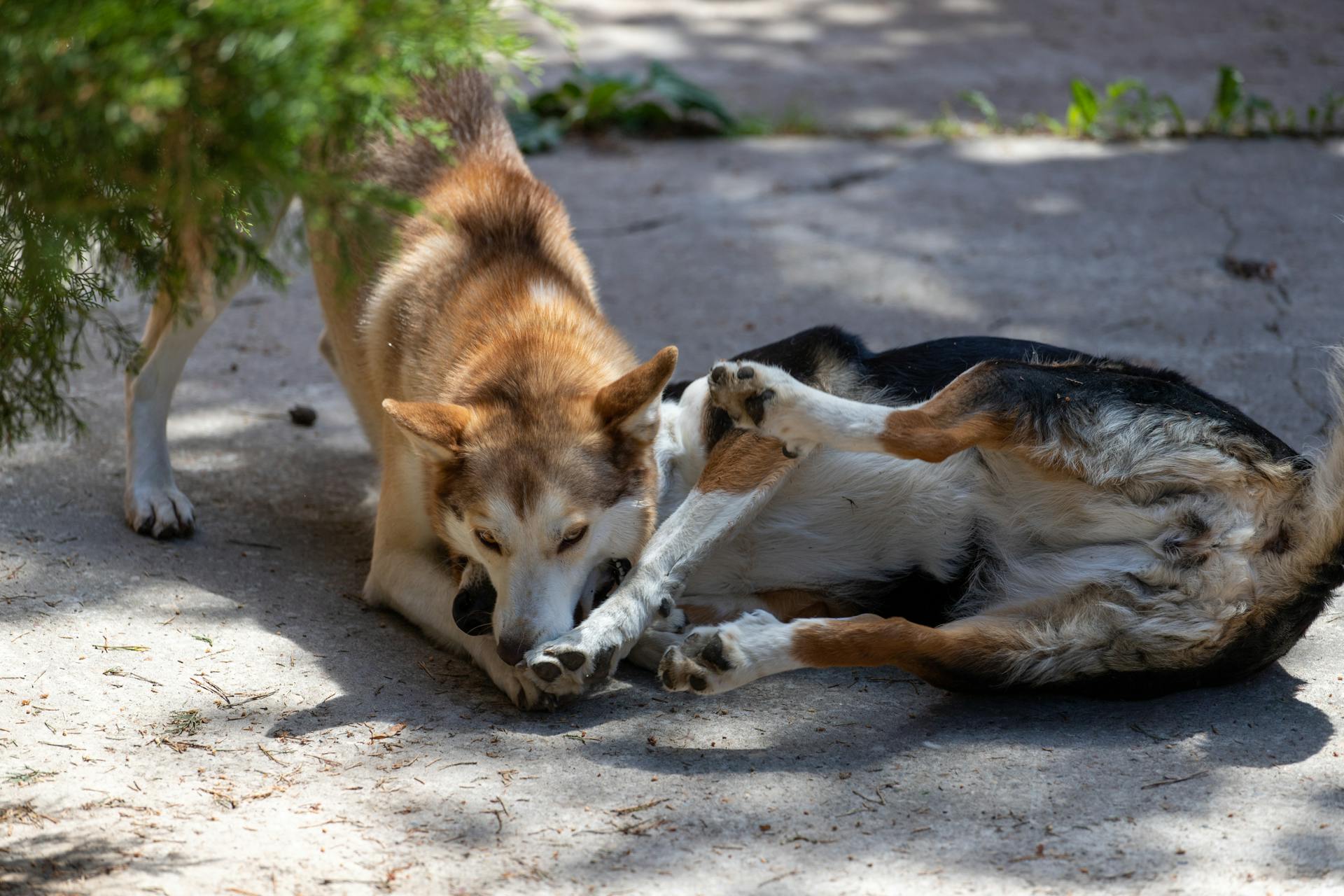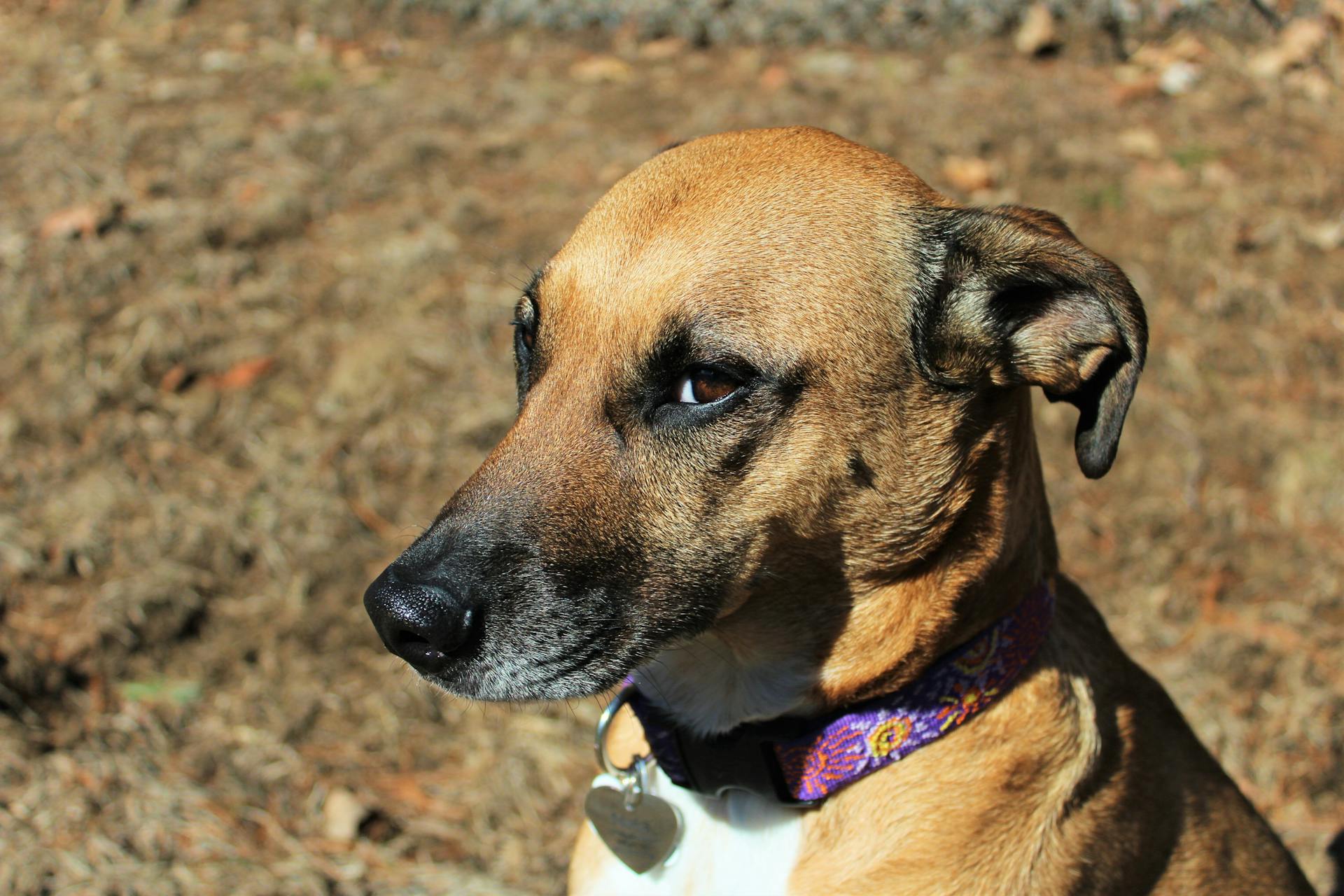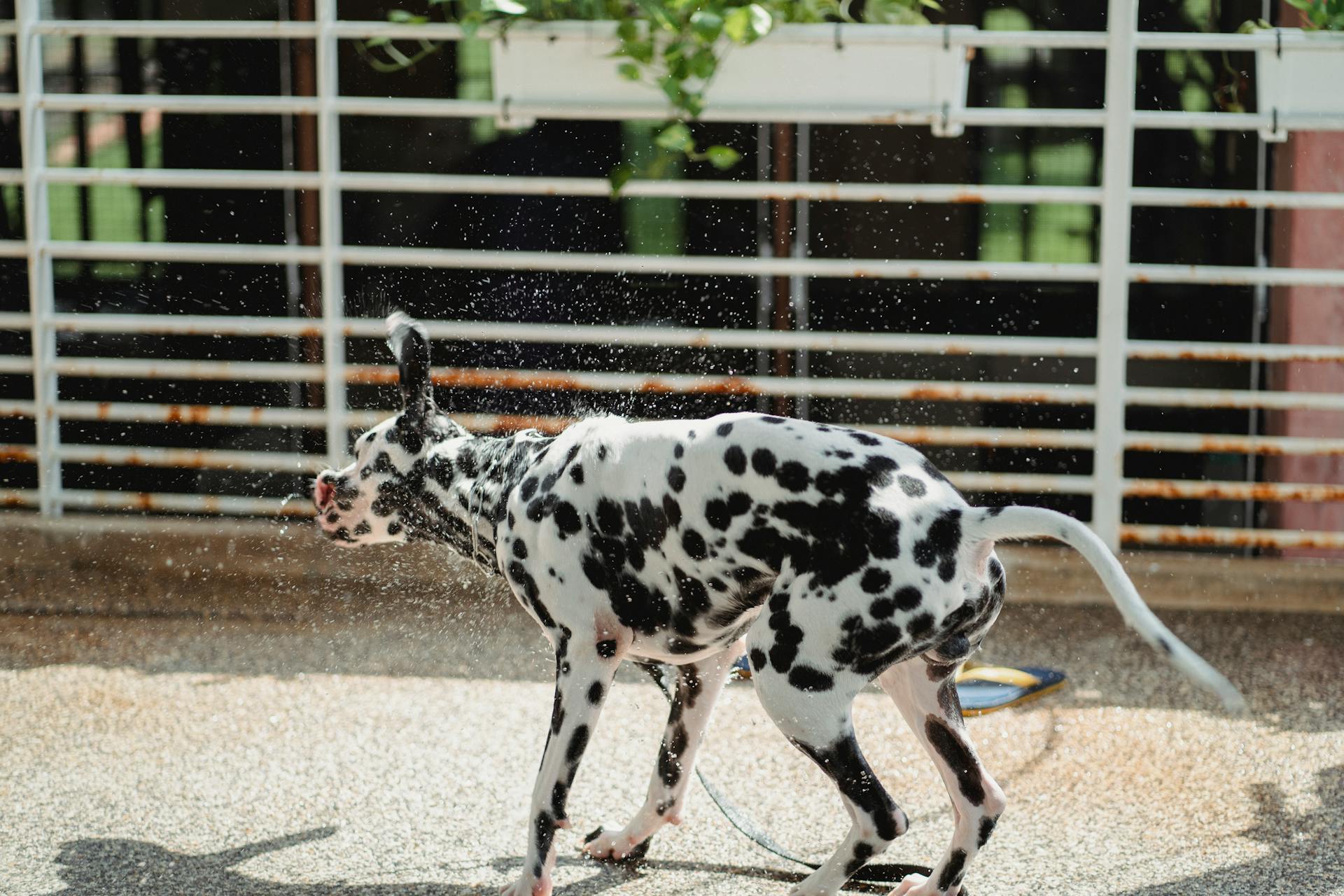
The Dangerous Dogs Act 1991 is a legislation that has been in place for over three decades, aiming to control and regulate the ownership of certain breeds of dogs.
The Act defines a "dangerous dog" as any dog that is of a type specified in the order, or any dog that is not of any of those types but is dangerously out of control in a public place.
This definition is crucial in understanding the implications of the Act, which holds dog owners accountable for their pets' actions.
The Act's primary goal is to prevent dog attacks and protect public safety, and it has had a significant impact on dog ownership and welfare in the UK.
Breed Legislation and Prohibitions
The Dangerous Dogs Act 1991 prohibits the ownership of certain dog breeds without an exemption from a court. The Act bans the breeding, sale, and exchange of these dogs, even if they're on the Index of Exempted Dogs.
The five types of dogs banned under the Act are Pit Bull Terrier, Japanese Tosa, Dogo Argentino, Fila Brasileiro, and XL Bully. XL Bully was added to the list in 2023, with the designation taking effect on December 31, 2023, for England and Wales, and February 23, 2024, for Scotland.
Cross-breeds of these five types of dog are also covered under the Act, and are classified by "type", not by breed label. This means a dog's prohibited status will depend on a judgement about its physical characteristics.
The Act makes it illegal to own, breed, breed from, sell, advertise, give away, or allow a dog of any of the listed breeds to stray. If you previously owned a prohibited breed, you can apply for a Certificate of Exemption for a limited period of time after the Act came into effect.
In Scotland, owners of XL Bully dogs must keep them muzzled and on a lead in public places from February 23, 2024. Breeding, selling, abandonment, and exchange of the dogs are also banned from this date.
Here are the specific breeds banned in the UK:
- Pit Bull Terrier
- Japanese Tosa
- Dogo Argentino
- Fila Brasileiro
- XL Bully
Note that the Act's focus is on the physical characteristics of a dog, rather than its breed label. A Dog Legislation Officer (DLO) will assess a dog's physical characteristics to determine its prohibited status.
Dangerous Dogs
A dog can be considered "dangerously out of control" if it causes fear or apprehension to a person that it may injure them.
If a dog injures someone, the offense is aggravated, and legal action may be taken against the owner and/or the person in charge of the dog at the time.
The UK government has banned certain dog breeds, including the American XL Bully dog, due to their powerful jaws that can cause significant injury to a person.
These breeds were banned because of their potential to cause harm, but many dog experts argue that other breeds, such as the Anatolian Shepherd Dog, are more powerful and should be considered equally restricted.
A dog can be considered "dangerously out of control" in both public spaces and private places, including your neighbor's property and your home.
Farmers can kill your dog without legal consequences if your dog injures their animals, even if they're unable to safely stop your dog from doing so.
A fresh viewpoint: Can Hypothyroidism Cause Seizures in Dogs
In Scotland, from February 23, 2024, owners of XL Bully dogs must keep their dogs muzzled and on a lead in public places.
Here are the dog breeds banned in the UK:
- American XL Bully dog
- Other breeds that possess powerful jaws, but are not listed here
Note that the specific breeds banned in the UK are not explicitly listed in the article, but it is mentioned that they possess powerful jaws that can cause significant injury to a person.
Control and Ownership
In the UK, the transfer of ownership of a dog registered as a dangerous breed is strictly regulated. The rules state that a dog can only be transferred to another owner in two specific cases: if the original owner has died or if the original owner is severely ill and unable to care for the dog.
The law surrounding ownership of dangerous dogs is clear: you can be considered "dangerously out of control" if your dog injures someone or if someone is worried that it could injure them. This includes both public places and private properties, such as your own home.
Index of Exempted

The Index of Exempted Dogs is a list of dogs that have been deemed safe for public ownership despite being breeds that are often restricted. The process for getting a dog on the Index involves proving to the court that the dog is not a danger to public safety.
To be eligible for the Index, dogs must be owned by a 'fit and proper' person and meet certain conditions. This includes being already neutered and microchipped, and having third-party insurance to cover incidents.
Dogs born before November 30, 1991 were initially eligible to be put on the Index, with over 8,000 applications received. Of these, 5,223 dogs received their Certificate of Exemption.
The Index is overseen by the Animal Welfare section of the Department for Environment, Food and Rural Affairs (Defra). As of 2015, there were 3,001 Pit bull terriers on the Index.
Proper Control
A dog being muzzled is defined as being securely fitted with a muzzle sufficient to prevent it biting any person.

In the UK, the law requires that a dog be securely held on a lead by a person who is at least 16 years old.
If a dog is considered "dangerously out of control", it can cause fear or apprehension to a person that it may injure them.
The Dangerous Dogs Act considers a dog to be "dangerously out of control" if it injures someone or if a person is worried that it could injure them.
In Scotland, from February 23, 2024, owners of certain dog breeds must keep them muzzled and on a lead in public places.
The law also requires that these dogs be bred, sold, abandoned, or exchanged no more than that date.
In fact, XL Bully owners in Scotland must apply for an exemption certificate to keep their dogs from July 31.
Recommended read: Shiba Inu with Owner
Transferring Ownership of an IED Registered Dog
Transferring Ownership of an IED Registered Dog can be a complex process. In England and Wales, the rules for transferring ownership are outlined in the Dangerous Dogs Exemption Schemes Order 2015.
Only two scenarios allow for the transfer of ownership: the original owner has passed away, or they are severely ill and unable to care for the dog. If the original owner is severely ill, they must be unable to provide proper care for the dog.
For more insights, see: Cockapoo Care
Consequences and Law
You can be fined up to £20,000 and/or sent to prison for up to 6 months if your dog is dangerously out of control.
If your dog injures someone, you can be incarcerated for up to 5 years and fined.
If your dog kills a person, you can be incarcerated for up to 14 years and receive a fine.
Dogs that are added to the Index of Exempted Dogs (IED) have to be on a leash, wear a muzzle, and be under the control of a person older than 16 years of age while in public.
You must show your Certificate of Exemption when asked by a police officer or council dog warden, either at the time or within 5 days.
If your dog injures a guide dog or another type of assistance/service dog, you can be sent to prison for up to 3 years and be fined.
Dogs under the "dangerous" classification must be housed at an address covered by appropriate pet insurance.
You can be prohibited from owning any dog if a court order is placed upon you.
A dog may be sent to be euthanized if it has caused injury or death to another animal or a person.
See what others are reading: My Dog Bit the Amazon Delivery Person
Banned Breeds and Specialists
The Dangerous Dogs Act 1991 has banned certain dog breeds in the UK. The Act covers five types of dogs: Pit Bull Terrier, Japanese Tosa, Dogo Argentino, Fila Brasileiro, and XL Bully.
These breeds are classified as "types", not by their breed label, which means a Dog Legislation Officer (DLO) assesses a dog's physical characteristics to determine if it matches the description of a prohibited "type".
The Act also covers cross-breeds of these five types of dog, making it illegal to own certain dogs without an exemption from a court.
Here are the five banned breeds:
- Pit Bull Terrier
- Japanese Tosa
- Dogo Argentino
- Fila Brasileiro
- XL Bully
In Scotland, from February 23, 2024, owners must keep XL Bully dogs muzzled and on a lead in public places, and apply for an exemption certificate to keep their dogs from July 31.
Other Specially
The Dangerous Dogs Act allows the Secretary of State to add new breeds to the list of banned dogs if they present a serious danger to the public.
This power is exercised through an order that imposes restrictions on the new breed, which can include requirements for muzzling and leading in public places.
The order can also provide exceptions for certain cases and conditions, and can create new offences punishable by imprisonment or fines.
The Secretary of State must consult with relevant experts, including animal welfare organizations and veterinary bodies, before making an order under this section.
The power to make an order is exercisable by statutory instrument, and the order must be laid before and approved by a resolution of each House of Parliament.
Here is a list of the types of restrictions that can be imposed under this section:
- Restrictions on the ownership of the new breed
- Requirements for muzzling and leading in public places
- Prohibitions on breeding, selling, and exchanging the new breed
- Exceptions for certain cases and conditions
- New offences punishable by imprisonment or fines
Dog Law Specialists
Dog Law Specialists are experts who understand the complexities of dog laws and regulations. They can help you navigate the system and make informed decisions about your dog.
Some Dog Law Specialists have experience working with breed-specific legislation, which has led to the banning of certain breeds in some countries. These experts know how to interpret the law and advocate for dog owners.
Dog Law Specialists often work with lawyers and other professionals to ensure that dog owners' rights are protected. They can provide guidance on how to handle situations involving dog bites, attacks, or other incidents.
Breed-specific legislation has been implemented in some countries to address concerns about public safety. However, this approach has been criticized for being unfair to dog owners who love their pets.
Dog Law Specialists can help you understand the laws and regulations surrounding your dog, regardless of its breed. They can provide information on local ordinances and help you comply with them.
Some Dog Law Specialists have experience working with dogs that have been seized by authorities due to breed-specific legislation. They know how to navigate the system and advocate for the dog's return.
A unique perspective: Breed-specific Legislation
Frequently Asked Questions
What is the literal rule of the Dangerous Dogs Act 1991?
Under the Dangerous Dogs Act 1991, the owner or person in charge of a dog is strictly liable for the dog's actions if it's out of control. This means they're responsible for any harm caused, regardless of fault or negligence.
What was the problem with the Dangerous Dogs Act 1991?
The Dangerous Dogs Act 1991 was widely criticized for failing to address the root causes of dog bites and aggression, instead relying on breed-specific legislation. This approach has been shown to be ineffective in reducing dog attacks.
Sources
- https://en.wikipedia.org/wiki/Dangerous_Dogs_Act_1991
- https://www.animallaw.info/statute/uk-dangerous-dogs-dangerous-dogs-act-1991
- https://www.supportdogcertification.org/article/what-dangerous-dogs-act-1991
- https://www.bicesteradvertiser.net/news/national/uk-today/24333991.dangerous-dog-act-1991-law-explained/
- https://doglaw.co.uk/dangerous-dogs/section-1-4b-dangerous-dogs-act-1991/
Featured Images: pexels.com


